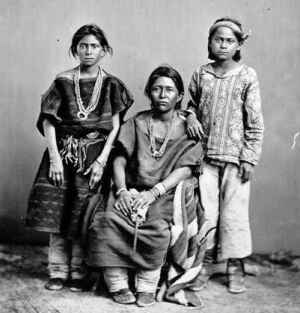 The Navajos are matriarchal and descent is traced through the mother. While the basic unit of social cooperation is the biological family, the term “family” is considerably broader in it’s application to Navajo society than it is in the white American world. A biological family, historically, lived in a cluster of hogans and nearby, usually within shouting distance, lived the “extended family.” An extended family would consist of an older woman, her husband and unmarried children, and her married daughters together with their husbands and unmarried children.
The Navajos are matriarchal and descent is traced through the mother. While the basic unit of social cooperation is the biological family, the term “family” is considerably broader in it’s application to Navajo society than it is in the white American world. A biological family, historically, lived in a cluster of hogans and nearby, usually within shouting distance, lived the “extended family.” An extended family would consist of an older woman, her husband and unmarried children, and her married daughters together with their husbands and unmarried children.
An extended family might also consist of unmarried, widowed or other relatives of the older woman of the household. Historically an extended family lived together in a designated vicinity and changed the place of residence as a group as the weather or foliage for the livestock dictated. Within the extended family labor is pooled to a great extent in herding and other productive activities. A man living with his wife’s family may also participate in the work activities of his own extended family.
 He often visits the homes of his mother and sisters and lends a helping hand in harvesting and other group activities. A man will sometimes pasture his livestock with that of his mother or sister rather than with the property of his wife and children.
He often visits the homes of his mother and sisters and lends a helping hand in harvesting and other group activities. A man will sometimes pasture his livestock with that of his mother or sister rather than with the property of his wife and children.
Until recently there was no conception of joint property ownership between husband and wife. As a result Navajo women have always enjoyed a favored and somewhat more “liberated” position in their society than have their white counterparts. A woman controls the hogan, built on land that was set aside for her by her family; she owns the children, which belong to her clan, her sheep, the product of her sheep and other livestock, her jewelry and all blankets she might weave and the income from the sale of any of her property. A husband owns what he has inherited from his own family and all goods which he has bought out of his own earnings which, nowadays, often includes a pick-up truck. Either partner may sell or trade what he owns, though one usually consults with the other about any major transactions. …………. Raymond Friday Locke

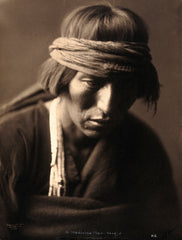 A storied culture that began more than 500 years ago, the Navajo people got their name from the phrase Teva Navahu; which means “highly-cultivated lands.” This designation seems rather apt, especially given that we now know that they are widely considered the largest of all Native American Indian tribes in the world.
A storied culture that began more than 500 years ago, the Navajo people got their name from the phrase Teva Navahu; which means “highly-cultivated lands.” This designation seems rather apt, especially given that we now know that they are widely considered the largest of all Native American Indian tribes in the world.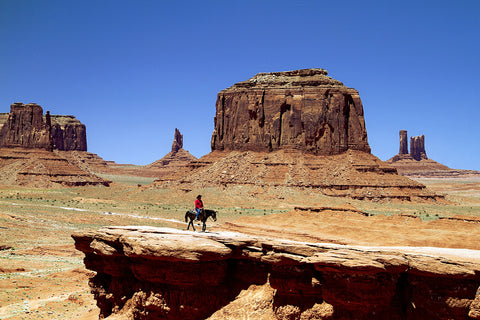 Later that same century the Navajo, the only indigenous people allowed to return to their home land, were released to return to their reservation. They found solace in their surroundings, raising their sheep and creating gorgeous textiles that gave them a prosperous edge in the changing financial times.
Later that same century the Navajo, the only indigenous people allowed to return to their home land, were released to return to their reservation. They found solace in their surroundings, raising their sheep and creating gorgeous textiles that gave them a prosperous edge in the changing financial times.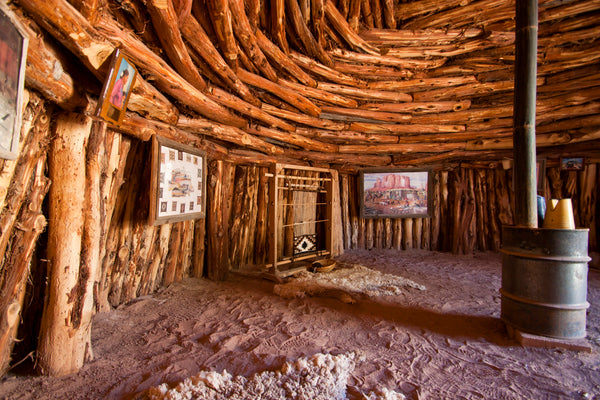 Beautiful Rainbow of the Navajo. At the center of the Navajo world is their shelter, the “HOGAN”. Navajos do not refer to their mode of living as a way of life… It is THE way of life …
Beautiful Rainbow of the Navajo. At the center of the Navajo world is their shelter, the “HOGAN”. Navajos do not refer to their mode of living as a way of life… It is THE way of life …  Today white prototype houses and even mobile homes are common on the reservation, but families that live in such dwellings also construct a hogan nearby. Many of the People have retained their native religion and Navajo ceremonies can be conducted only in a hogan.
Today white prototype houses and even mobile homes are common on the reservation, but families that live in such dwellings also construct a hogan nearby. Many of the People have retained their native religion and Navajo ceremonies can be conducted only in a hogan.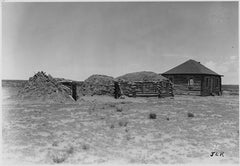 The Navajo hogan is more than just a place to eat and sleep and the concept of it as a “home” bears little resemblance to a white person’s attitude toward his dwelling place. The hogan is a gift of the gods and as such it occupies a place in the sacred world. The first hogans were built by the Holy People of turquoise, white shell, jet, and abalone shell. The round hogan is symbolic of the sun and its door faces east so that the first thing that a Navajo family sees in the morning is the rising sun…. Father Sun, one of the most revered of the Navajo deities. The construction of a new hogan is almost always a community affair. Once completed, the new hogan is consecrated with a Blessing Way rite whereby the Holy People are asked to “let this place be happy.”
The Navajo hogan is more than just a place to eat and sleep and the concept of it as a “home” bears little resemblance to a white person’s attitude toward his dwelling place. The hogan is a gift of the gods and as such it occupies a place in the sacred world. The first hogans were built by the Holy People of turquoise, white shell, jet, and abalone shell. The round hogan is symbolic of the sun and its door faces east so that the first thing that a Navajo family sees in the morning is the rising sun…. Father Sun, one of the most revered of the Navajo deities. The construction of a new hogan is almost always a community affair. Once completed, the new hogan is consecrated with a Blessing Way rite whereby the Holy People are asked to “let this place be happy.”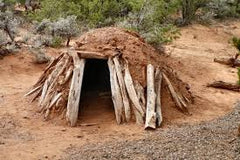 Also nearby, but out of sight, will be at least one sweat hogan. The sweat hogan is small scale replica of the old-style forked stick hogan but without the smoke hole. It is constructed of three sticks with forked ends which are fasten together in a tripod. Two straight sticks are leaned against the apes from the east to make the sides of the door. It is heated by placing hot rocks within, the door being closed with several blankets.
Also nearby, but out of sight, will be at least one sweat hogan. The sweat hogan is small scale replica of the old-style forked stick hogan but without the smoke hole. It is constructed of three sticks with forked ends which are fasten together in a tripod. Two straight sticks are leaned against the apes from the east to make the sides of the door. It is heated by placing hot rocks within, the door being closed with several blankets. 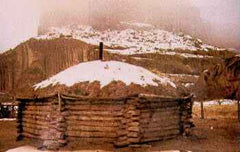 Traditional structured hogans are also considered pioneers of energy efficient homes. Using packed mud against the entire wood structure, the home was kept cool by natural air ventilation and water sprinkled on the dirt ground inside. During the winter, the fireplace kept the inside warm for a long period of time and well into the night.
Traditional structured hogans are also considered pioneers of energy efficient homes. Using packed mud against the entire wood structure, the home was kept cool by natural air ventilation and water sprinkled on the dirt ground inside. During the winter, the fireplace kept the inside warm for a long period of time and well into the night. 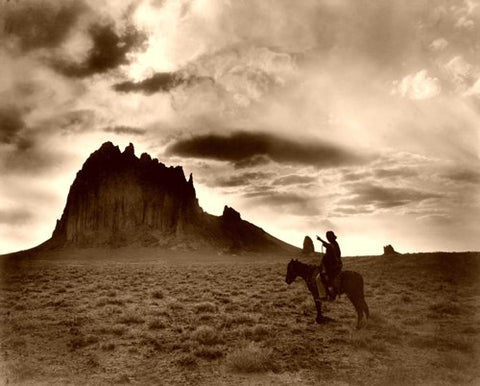 First there was a beautiful and rugged land. And then came the people to the land and they called themselves Dineh. But they, the descendants of those Athapascan-speaking people would come to be known by many names. Dineh (or Dine), their name for themselves, cannot be translated exactly into English as there are no articles in the Navajo Language. The translation, “The People,” is formally permissible and accepted by most linguists and anthropologists, but Dinehcan also be translated as “men,” or “people” or even “earth people.”
First there was a beautiful and rugged land. And then came the people to the land and they called themselves Dineh. But they, the descendants of those Athapascan-speaking people would come to be known by many names. Dineh (or Dine), their name for themselves, cannot be translated exactly into English as there are no articles in the Navajo Language. The translation, “The People,” is formally permissible and accepted by most linguists and anthropologists, but Dinehcan also be translated as “men,” or “people” or even “earth people.”